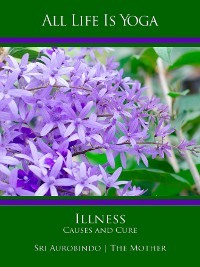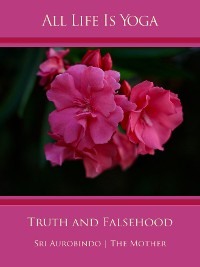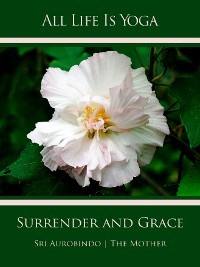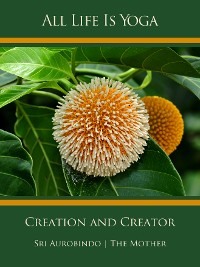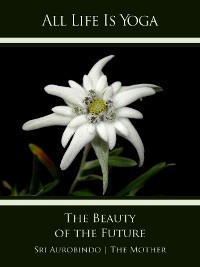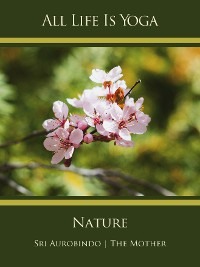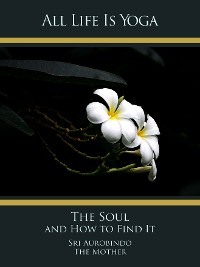
Полная версия
All Life Is Yoga: Sri Aurobindo Ashram

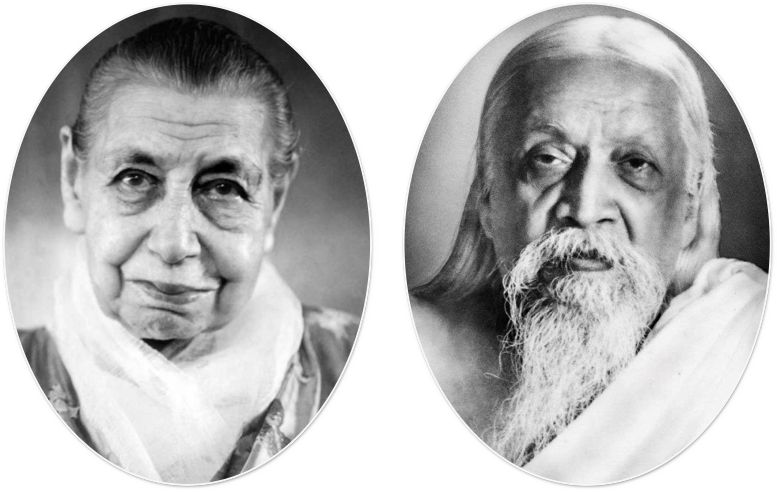
Omsriaurobindomira
All
Life
Is
Yoga
“All life is Yoga.” – Sri Aurobindo
Sri Aurobindo Ashram
Sri Aurobindo | The Mother

SRI AUROBINDO
DIGITAL EDITION

Copyright 2020
AURO MEDIA
Verlag und Fachbuchhandel
Wilfried Schuh
www.auro.media
www.savitri.center
www.sriaurobindo.center
eBook Design

SRI AUROBINDO DIGITAL EDITION
Germany, Berchtesgaden
www.auromira.digital
ALL LIFE IS YOGA
Sri Aurobindo Ashram Selections from the Works of Sri Aurobindo and The Mother Second edition 2020 ISBN 978-3-96387-006-4
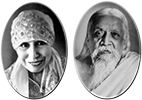
© Photos and selections of the works of Sri Aurobindo and the Mother:
Sri Aurobindo Ashram Trust
Puducherry, India

Flower on the cover:
Ornithogalum umbellatum. White. Spiritual significance and explanation given by the Mother: Beauty in collective simplicity Each element plays its part in the whole.
Publisher’s Note
This is one in a series of some e-books created by SRI AUROBINDO DIGITAL EDITION and published by AURO MEDIA under the title All Life Is Yoga. Our effort is to bring together, from Sri Aurobindo and the Mother, simple passages with a practical orientation on specific subjects, so that everyone may feel free to choose a book according to his inner need. The topics cover the whole field of human activity, because true spirituality is not the rejection of life but the art of perfecting life.
While the passages from Sri Aurobindo are in the original English, most of the passages from the Mother (selections from her talks and writings) are translations from the original French. We must also bear in mind that the excerpts have been taken out of their original context and that a compilation, in its very nature, is likely to have a personal and subjective approach. A sincere attempt, however, has been made to be faithful to the vision of Sri Aurobindo and the Mother. These excerpts are by no means exhaustive.
Bringing out a compilation from the writings of Sri Aurobindo and the Mother, which have a profound depth and wideness unique, is a difficult task. The compiler’s subjective tilt and preferences generally result in highlighting some aspects of the issues concerned while the rest is by no means less significant. Also without contexts of the excerpts the passages reproduced may not fully convey the idea – or may be misunderstood or may reduce a comprehensive truth into what could appear like a fixed principle.
The reader may keep in mind this inherent limitation of compilations; compilations are however helpful in providing an introduction to the subject in a handy format. They also give the readers a direct and practical feel of some of the profound issues and sometimes a mantric appeal, musing on which can change one’s entire attitude to them.
The excerpts from the writings of Sri Aurobindo and the Mother carry titles and captions chosen by the editor, highlighting the theme of the excerpts and, whenever possible, borrowing a phrase from the text itself. The sources of the excerpts are given at the end of each issue.
We hope these compilations will inspire the readers to go to the complete works of Sri Aurobindo and the Mother and will help them to mould their lives and their environments towards an ever greater perfection.
“True spirituality is not to renounce life, but to make life perfect with a Divine Perfection.” – The Mother
* * *
ContentsTitle PageCopyrightPublisher’s NoteQuotationI. PRELIMINARY1. Spiritual Life – Religious Life – Ordinary Life2. The Object of Our Yoga3. The Entire Purpose of Yoga4. Satyayuga – The Age of TruthII. WE HAVE SET OUT TO CONQUER THE WORLD FOR GOD1. The Integral Yoga – A Spiritual Adventure2. Life We Must Accept in Our Yoga3. Conditions for a New Collective LifeIII. STEPS ON THE WAY1. Collective Progress and Individual Progress2. The Most Useful WorkIV. SPIRITUAL COMMUNITY1. The Necessity for a True Communal Life2. The Foundation of the Ashram3. Acceptance and Admission4. The Aim and Purpose of the Ashram5. The Ashram – A Laboratory6. Yoga Centres7. The Ideal CentreV. TO THE SADHAKS1. If You Want to Be a True Doer of Divine Works2. Some Advices3. Rules and Discipline4. Work5. I Am With YouAPPENDIXReferencesGuideCoverTable of ContentsStart Reading

Sri Aurobindo
Our aim is not, either, to found a religion or a school of philosophy or a school of Yoga, but to create a ground and a way of spiritual growth and experience which will bring down a greater Truth beyond the mind but not inaccessible to the human soul and consciousness. All can pass who are drawn to that Truth, whether they are from India or elsewhere, from the East or from the West. All may find great difficulties in their personal or common human nature; but it is not their physical origin or their racial temperament that can be an insuperable obstacle to their deliverance. — Sri Aurobindo
* * *
Chapter 1
Spiritual Life – Religious Life – Ordinary Life
Words of Sri Aurobindo
The spiritual life (adhyatma jivana), the religious life (dharma jivana) and the ordinary human life of which morality is a part are three quite different things and one must know which one desires and not confuse the three together. The ordinary life is that of the average human consciousness separated from its own true self and from the Divine and led by the common habits of the mind, life and body which are the laws of the Ignorance. The religious life is a movement of the same ignorant human consciousness, turning or trying to turn away from the earth towards the Divine but as yet without knowledge and led by the dogmatic tenets and rules of some sect or creed which claims to have found the way out of the bonds of the earth-consciousness into some beatific Beyond. The religious life may be the first approach to the spiritual, but very often it is only a turning about in a round of rites, ceremonies and practices or set ideas and forms without any issue. The spiritual life, on the contrary, proceeds directly by a change of consciousness, a change from the ordinary consciousness, ignorant and separated from its true self and from God, to a greater consciousness in which one finds one’s true being and comes first into direct and living contact and then into union with the Divine. For the spiritual seeker this change of consciousness is the one thing he seeks and nothing else matters.
* * *
Chapter 2
The Object of Our Yoga
Words of Sri Aurobindo
The object of our Yoga is self-perfection, not self-annulment. There are two paths set for the feet of the Yogin, withdrawal from the universe and perfection in the Universe; the first comes by asceticism, the second is effected by tapasya; the first receives us when we lose God in Existence, the second is attained when we fulfil existence in God. Let ours be the path of perfection, not of abandonment; let our aim be victory in the battle, not the escape from all conflict.
Buddha and Shankara supposed the world to be radically false and miserable; therefore escape from the world was to them the only wisdom. But this world is Brahman, the world is God, the world is Satyam, the world is Ananda; it is our misreading of the world through mental egoism that is a falsehood and our wrong relation with God in the world that is a misery. There is no other falsity and no other cause of sorrow.
God created the world in Himself through Maya; but the Vedic meaning of Maya is not illusion, it is wisdom, knowledge, capacity, wide extension in consciousness. Prajna prasrita purani. Omnipotent Wisdom created the world, it is not the organised blunder of some Infinite Dreamer; omniscient Power manifests or conceals it in Itself or Its own delight, it is not a bondage imposed by His own ignorance on the free and absolute Brahman.
If the world were Brahman’s self-imposed nightmare, to awake from it would be the natural and only goal of our supreme endeavour; or if life in the world were irrevocably bound to misery, a means of escape from this bondage would be the sole secret worth discovering. But perfect truth in world-existence is possible, for God here sees all things with the eye of truth; and perfect bliss in the world is possible, for God enjoys all things with the sense of unalloyed freedom. We also can enjoy this truth and bliss, called by the Veda amritam, Immortality, if by casting away our egoistic existence into perfect unity with His being we consent to receive the divine perception and the divine freedom.
The world is a movement of God in His own being; we are the centres and knots of divine consciousness which sum up and support the processes of His movement. The world is His play with His own self-conscious delight, He who alone exists, infinite, free and perfect; we are the self-multiplications of that conscious delight, thrown out into being to be His playmates. The world is a formula, a rhythm, a symbol-system expressing God to Himself in His own consciousness, – it has no material existence but exists only in His consciousness and self-expression; we, like God, are in our inward being That which is expressed, but in our outward being terms of that formula, notes of that rhythm, symbols of that system. Let us lead forward God’s movement, play out His play, work out His formula, execute His harmony, express Him through ourselves in His system. This is our joy and our self-fulfilment; to this end we who transcend and exceed the universe, have entered into universe-existence.
Perfection has to be worked out, harmony has to be accomplished. Imperfection, limitation, death, grief, ignorance, matter, are only the first terms of the formula – unintelligible till we have worked out the wider terms and reinterpreted the formulary; they are the initial discords of the musician’s tuning. Out of imperfection we have to construct perfection, out of limitation to discover infinity, out of death to find immortality, out of grief to recover divine bliss, out of ignorance to rescue divine self-knowledge, out of matter to reveal Spirit. To work out this end for ourselves and for humanity is the object of our Yogic practice.
* * *
Chapter 3
The Entire Purpose of Yoga
Words of Sri Aurobindo
By Yoga we can rise out of falsehood into truth, out of weakness into force, out of pain and grief into bliss, out of bondage into freedom, out of death into immortality, out of darkness into light, out of confusion into purity, out of imperfection into perfection, out of self-division into unity, out of Maya into God. All other utilisation of Yoga is for special and fragmentary advantages not always worth pursuing. Only that which aims at possessing the fullness of God is purna Yoga; the sadhaka of the Divine Perfection is the purna Yogin.
Our aim must be to be perfect as God in His being and bliss is perfect, pure as He is pure, blissful as He is blissful, and, when we are ourselves siddha in the purna Yoga, to bring all mankind to the same divine perfection. It does not matter if for the present we fall short of our aim, so long as we give ourselves whole-heartedly to the attempt and by living constantly in it and for it move forward even two inches upon the road; even that will help to lead humanity out of the struggle and twilight in which it now dwells into the luminous joy which God intends for us. But whatever our immediate success, our unvarying aim must be to perform the whole journey and not lie down content in any wayside stage or imperfect resting place.
All Yoga which takes you entirely away from the world, is a high but narrow specialisation of divine tapasya. God in His perfection embraces everything; you also must become all-embracing...
Philosophies and religions dispute about the priority of different aspects of God and different Yogins, Rishis and Saints have preferred this or that philosophy or religion. Our business is not to dispute about any of them, but to realise and become all of them, not to follow after any aspect to the exclusion of the rest, but to embrace God in all His aspects and beyond aspect.
God descending into world in various forms has consummated on this earth the mental and bodily form which we call humanity.
He has manifested in the world through the play of all-governing Soul with its own formative Will or Shakti a rhythm of existence of which Matter is the lowest term and pure being the highest. Mind and Life stand upon Matter (Manasand Prana on Annam) and make the lower half of world-existence (aparardha); pure consciousness and pure bliss proceed out of pure Being (Chit and Ananda out of Sat) and make the upper half of world-existence. Pure idea (vijnana) stands as the link between the two. These seven principles or terms of existence are the basis of the sevenfold world of the Puranas (Satyaloka, Tapas, Jana, Mahar, Swar, Bhuvar and Bhur).
The lower hemisphere in this arrangement of consciousness consists of the three vyahritis of the Veda, “Bhur, Bhuvah, Swar”; they are states of consciousness in which the principles of the upper world are expressed or try to express themselves under different conditions. Pure in their own homes, they are in this foreign country subject to perverse, impure and disturbing combinations and workings. The ultimate object of life is to get rid of the perversity, impurity and disturbance and express them perfectly in these other conditions. Your life on this earth is a divine poem that you are translating into earthly language or a strain of music which you are rendering into words.
Being in Sat is one in multiplicity, one that regards its multiplicity without being lost or confused in it and multiplicity that knows itself as one without losing the power of multiple play in the universe. Under the conditions of mind, life and body, ahankara is born, the subjective or objective form of consciousness is falsely taken for self-existent being, the body for an independent reality and the ego for an independent personality; the one loses itself in us in its multiplicity and when it recovers its unity, finds it difficult, owing to the nature of mind, to preserve its play of multiplicity. Therefore when we are absorbed in world, we miss God in Himself; when we seek God, we miss Him in the world. Our business is to break down and dissolve the mental ego and get back to our divine unity without losing our power of individual and multiple existence in the universe.
Consciousness in Chit is luminous, free, illimitable and effective; that which it is aware of as Chit (Jnanashakti) it fulfils infallibly as Tapas (Kriyashakti); for Jnanashakti is only the stable and comprehensive, Kriyashakti only the motional and intensive form of one self-luminous Conscious Being. They are one power of conscious force of God (Chit-Shakti of Sat-Purusha). But in the lower hemisphere, under the conditions of mind, life and body, the luminousness becomes divided and broken up into uneven rays, the freedom trammelled by egoism and unequal forms, the effectiveness veiled by the uneven play of forces. We have, therefore, states of consciousness, non-consciousness and false consciousness, knowledge and ignorance and false knowledge, effective force and inertia and ineffective force. Our business is by renouncing our divided and unequal individual force of action and thought into the one, undivided universal Chitshakti of Kali to replace our egoistic activities by the play in our body of the universal Kali and thus exchange blindness and ignorance for knowledge and ineffective human strength for the divine effective Force.
Delight in Ananda is pure, unmixed, one and yet multitudinous. Under the conditions of mind, life and body it becomes divided, limited, confused and misdirected and owing to shocks of unequal forces and uneven distribution of Ananda subject to the duality of positive and negative movements, grief and joy, pain and pleasure. Our business is to dissolve these dualities by breaking down their cause and plunge ourselves into the ocean of divine bliss, one, multitudinous, evenly distributed (sama), which takes delight from all things and recoils painfully from none.
In brief, we have to replace dualities by unity, egoism by divine consciousness, ignorance by divine wisdom, thought by divine knowledge, weakness, struggle and effort by self-contented divine force, pain and false pleasure by divine bliss. This is called in the language of Christ bringing down the kingdom of heaven on earth, or in modern language, realising and effectuating God in the world.
* * *
Chapter 4
Satyayuga – The Age of Truth
Words of Sri Aurobindo
The yoga we practise is not for ourselves alone, but for the Divine; its aim is to work out the will of the Divine in the world, to effect a spiritual transformation and to bring down a divine nature and a divine life into the mental, vital and physical nature and life of humanity. Its object is not personal Mukti, although Mukti is a necessary condition of the yoga, but the liberation and transformation of the human being. It is not personal Ananda, but the bringing down of the divine Ananda – Christ’s kingdom of heaven, our Satyayuga – upon the earth...
In modern language the Satyayuga is a period of the world in which a harmony, stable and sufficient, is created and man realises for a time, under certain conditions and limitations, the perfection of his being. The harmony exists in its nature, by the force of a settled purity; but afterwards it begins to break down and man upholds it, in the Treta, by force of will, individual and collective; it breaks down further and he attempts to uphold it in the Dwapara by intellectual regulation and common consent and rule; then in the Kali it finally collapses and is destroyed. But the Kali is not merely evil; in it the necessary conditions are progressively built up for a new Satya, another harmony, a more advanced perfection. In the period of the Kali which has passed, still endures in its effects, but is now at an end, there has been a general destruction of the ancient knowledge and culture. Only a few fragments remain to us in the Vedas, Upanishads and other sacred works and in the world’s confused traditions. But the time is at hand for a first movement upward, the first attempt to build up a new harmony and perfection. That is the reason why so many ideas are abroad for the perfection of human society, knowledge, religion and morals. But the true harmony has not yet been found.
It is only India that can discover the harmony, because it is only by a change – not a mere readjustment – of man’s present nature that it can be developed, and such a change is not possible except by yoga. The nature of man and of things is at present a discord, a harmony that has got out of tune. The whole heart and action and mind of man must be changed, but from within, not from without, not by political and social institutions, not even by creeds and philosophies, but by realisation of God in ourselves and the world and a remoulding of life by that realisation. This can only be effected by Purnayoga, a yoga not devoted to a particular purpose, even though that purpose be Mukti or Ananda, but to the fulfilment of the divine humanity in ourselves and others. For this purpose the practices of Hatha and Raja Yoga are not sufficient and even the Trimarga will not serve; we must go higher and resort to the Adhyatmayoga.
* * *
Chapter 1
The Integral Yoga – A Spiritual Adventure
Words of Sri Aurobindo
I know very well also that there have been seemingly allied ideals and anticipations – the perfectibility of the race, certain Tantric sadhanas, the effort after a complete physical siddhi by certain schools of Yoga, etc. etc. I have alluded to these things myself and have put forth the view that the spiritual past of the race has been a preparation of Nature not merely for attaining to the Divine beyond this world, but also for this very step forward which the evolution of the earth-consciousness has still to make. I do not therefore care in the least, – even though these ideals were, up to some extent parallel, yet not identical with mine, – whether this Yoga and its aim and method are accepted as new or not; that is in itself a trifling matter. That it should be recognised as true in itself by those who can accept or practise it and should make itself true by achievement, is the one thing important; it does not matter if it is called new or a repetition or revival of the old which was forgotten. I laid emphasis on it as new in a letter to certain sadhaks so as to explain to them that a repetition of the aim and idea of the old Yogas was not enough in my eyes, that I was putting forward a thing to be achieved that has not yet been achieved, not yet clearly visualised, even though it is one natural but still secret destined outcome of all the past spiritual endeavour.
It is new as compared with the old Yogas:
(1) Because it aims not at a departure out of world and life into a Heaven or a Nirvana, but at a change of life and existence, not as something subordinate or incidental, but as a distinct and central object. If there is a descent in other Yogas, yet it is only an incident on the way or resulting from the ascent – the ascent is the real thing. Here the ascent is indispensable, but what is decisive, what is finally aimed at is the resulting descent. It is the descent of the new consciousness attained by the ascent that is the stamp and seal of the sadhana. Even Tantra and Vaishnavism end in the release from life; here the object is the divine fulfilment of life.
(2) Because the object sought after is not an individual achievement of divine realisation for the sole sake of the individual, but something to be gained for the earth-consciousness here, a cosmic, not solely a supra-cosmic achievement. The thing to be gained also is the bringing in of a Power of consciousness (the supramental) not yet organised or active directly in earth-nature, even in the spiritual life, but yet to be organised and made directly active.
(3) Because a method has been preconised for achieving this purpose which is as total and integral as the aim set before it, viz. the total and integral change of the consciousness and nature, taking up old methods but only as a part action and passing on to others that are distinctive. I have not found this method (as a whole) or anything like it in its totality proposed or realised in the old Yogas. If I had I should not have wasted my time in hewing out a road and in thirty years of search and inner creation when I could have hastened home safely to my goal in an easy canter over paths already blazed out, laid down, perfectly mapped, macadamised, made secure and public. Our Yoga is not a retreading of old walks, but a spiritual adventure.


